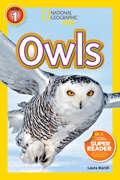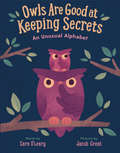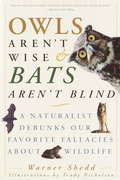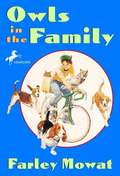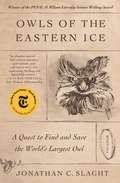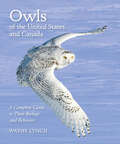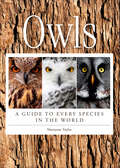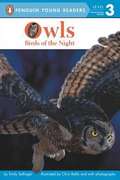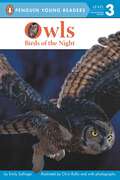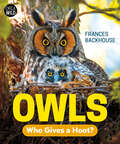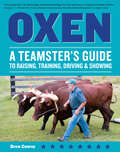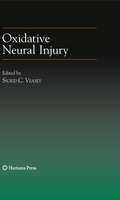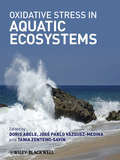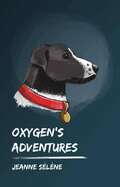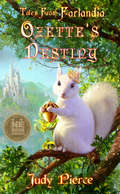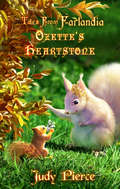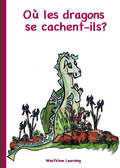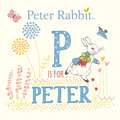- Table View
- List View
Owls (Readers)
by Laura MarshIn this level 1 reader, young readers will explore the feathery world of adorable owls. Follow these curious-looking creatures through their wooded habitats, and learn how owls raise their young, hunt, and protect themselves. Beautiful photos and carefully leveled text make this book perfect for reading aloud or for independent reading.
Owls Are Good At Keeping Secrets: An Unusual Alphabet
by Sara O'LearyFrom the author of the beloved This Is Sadie comes a delightful book of curious, little-known stories about animals -- one for each letter of the alphabet!Did you know that chipmunks love to stay up past their bedtime? Or that dragons cry at happy endings? I bet you'd never have guessed that iguanas sometimes get homesick at sleepovers.Sara O'Leary pulls back the curtain on the animal world and gives us absolutely charming little one-line "facts" about an animal for each letter of the alphabet. Kids will love to see their own quirks reflected in these adorably-rendered creatures, and perhaps will be comforted to know that, just like them, narwhals can be perfectly happy all on their own and quail also get tired of being told to be quiet.This is more than just an alphabet book -- it is a charming, hilarious and touching look at the diversity of personalities in the world, worth many, many re-reads.
Owls Aren't Wise and Bats Aren't Blind: A Naturalist Debunks Our Favorite Fallacies About Wildlife
by Warner SheddDid you know that "flying" squirrels are incapable of true flight? Were you aware that opossums don't "play dead," as in the common folk saying "playing possum"? In this fascinating and gorgeously illustrated new book, wildlife expert and enthusiast Warner Shedd, former executive for the National Wildlife Federation, uncovers the scientific realities obscured by our numerous long-held misconceptions of wild animals. Setting the most tenacious of these age-old superstitions against evidence that he and other biologists and naturalists have gleaned from careful observation and investigation, Shedd refutes such popular myths as beavers can fell trees in a desired direction, gray squirrels remember where they bury nuts, wolves howl at the moon, and cougars are an endangered species. In addition to dispelling misinformation,Owls Aren't Wise & Bats Aren't Blindpresents some fascinating facts about the animals that many of us encounter in our own backyards or walking across the road as we drive in our cars. For instance, did you know that a porcupine is actually a large rodent, and that its protective quills are really specialized hairs numbering about 30,000 per animal? That means that a typical porcupine has about 140 quills per square inch! Shedd also uses humorous anecdotes to show us how funny (and educational) it can be when animals themselves defy our mistaken beliefs about them. Casting new light on the old tenet that ravens can be taught to mimic the human voice, Warner Shedd tells of a scientist who spent six years teaching a raven to cry "nevermore," after the haunting raven in the famous Edgar Allan Poe poem. Shedd further explains that recent research indicates that ravens only mimic if they have the desire to do so. Owls Aren't Wise & Bats Aren't Blindcovers more than thirty North American species--some as familiar as the common toad, others as elusive as the lynx. And Shedd captivates the reader as only an experienced naturalist could, with detailed, accurate information on such varied wildlife as muskrats, herons, brown bears, crows, armadillos, and coyotes--to name only a few. Owls Aren't Wise & Bats Aren't Blindgrew out of Warner Shedd's desire to share biologically sound information and counter erroneous folklore about wild animals. By arming his readers with knowledge, Shedd hopes to promote a more informed and respectful view of many North American wildlife species and ultimately encourage the scientific management and conservation of all our native wildlife.
Owls and Other Birds of Prey (World Book's Animals of the World)
by Mary E. ReidHow do Owls see in the dark? How can they fly silently? Do bald eagles steal from other birds? What is the fastest bird in the world? Find out the answers to these and other questions in this fascinating book on birds of prey.
Owls are Good at Keeping Secrets: An Unusual Alphabet
by Sara O'LearyA delightful book of curious, little-known "facts" about animals--one for each letter of the alphabet!Did you know that chipmunks love to stay up past their bedtime? Or that dragons cry at happy endings? I bet you'd never have guessed that iguanas sometimes get homesick at sleepovers.Sara O'Leary pulls back the curtain on the animal world and gives us an absolutely charming little one-line "fact" about one animal for each letter of the alphabet. Kids will love to see their own quirks reflected in these adorably rendered creatures, and perhaps will be comforted to know that--just like them--narwhals can be perfectly happy all on their own and quail also get tired of being told to be quiet.This is more than just an alphabet book. It's a charming, hilarious, and touching look at the diversity of personalities in the world--worth many, many rereads.
Owls in the Family
by Farley MowatTwo owls from Saskatchewan come to a neighborhood and shake up the whole town.
Owls of the Eastern Ice: A Quest to Find and Save the World's Largest Owl
by Jonathan C. SlaghtA New York Times Notable Book of 2020Longlisted for the National Book AwardWinner of the PEN/E.O. Wilson Literary Science Writing Award and the Minnesota Book Award for General NonfictionA Finalist for the Stanford Dolman Travel Book of the Year AwardWinner of the Peace Corps Worldwide Special Book AwardA Best Book of the Year: NPR, The Wall Street Journal, Smithsonian, Minneapolis Star-Tribune, The Globe and Mail, The BirdBooker Report, Geographical, Open Letter ReviewBest Nature Book of the Year: The Times (London)"A terrifically exciting account of [Slaght's] time in the Russian Far East studying Blakiston’s fish owls, huge, shaggy-feathered, yellow-eyed, and elusive birds that hunt fish by wading in icy water . . . Even on the hottest summer days this book will transport you.” —Helen Macdonald, author of H is for Hawk, in KirkusI saw my first Blakiston’s fish owl in the Russian province of Primorye, a coastal talon of land hooking south into the belly of Northeast Asia . . . No scientist had seen a Blakiston’s fish owl so far south in a hundred years . . . When he was just a fledgling birdwatcher, Jonathan C. Slaght had a chance encounter with one of the most mysterious birds on Earth. Bigger than any owl he knew, it looked like a small bear with decorative feathers. He snapped a quick photo and shared it with experts. Soon he was on a five-year journey, searching for this enormous, enigmatic creature in the lush, remote forests of eastern Russia. That first sighting set his calling as a scientist.Despite a wingspan of six feet and a height of over two feet, the Blakiston’s fish owl is highly elusive. They are easiest to find in winter, when their tracks mark the snowy banks of the rivers where they feed. They are also endangered. And so, as Slaght and his devoted team set out to locate the owls, they aim to craft a conservation plan that helps ensure the species’ survival. This quest sends them on all-night monitoring missions in freezing tents, mad dashes across thawing rivers, and free-climbs up rotting trees to check nests for precious eggs. They use cutting-edge tracking technology and improvise ingenious traps. And all along, they must keep watch against a run-in with a bear or an Amur tiger. At the heart of Slaght’s story are the fish owls themselves: cunning hunters, devoted parents, singers of eerie duets, and survivors in a harsh and shrinking habitat.Through this rare glimpse into the everyday life of a field scientist and conservationist, Owls of the Eastern Ice testifies to the determination and creativity essential to scientific advancement and serves as a powerful reminder of the beauty, strength, and vulnerability of the natural world.
Owls of the United States and Canada: A Complete Guide to Their Biology and Behavior
by Wayne LynchNamed One of the Best Reference Books of 2007 by Library JournalThere is no group of birds more mysterious and fascinating than owls. The loudmouths of the raptor world, they peep, trill, toot, bark, growl, shriek, whistle, chittle, whoop, chuckle, boom, and buzz. Indeed, very few actually "hoot." They have become the stuff of lore and legend—from the Roman myth that an owl foot could reveal secrets to the First Nations belief that an owl feather could give a newborn better night vision. But the truth about owls is much more exciting.In this gorgeous book, celebrated natural history writer and wildlife photographer Wayne Lynch reveals the secrets of these elusive species with stunning photographs, personal anecdotes, and accessible science. The photos alone are masterpieces. Unlike most published owl photos, which are portraits of birds in captivity, the vast majority of these were taken in the wild—a product of the author-photographer's incredible knowledge and patience. Lynch complements the photos with a wealth of facts about anatomy, habitat, diet, and family life. For each of the nineteen species that inhabit Canada and the United States, he provides a range map and a brief discussion of its distribution, population size, and status. Lynch debunks myths about owls' "supernatural" powers of sight and hearing, discusses courtship rituals, and offers personal tips for finding owls in the wild. From the great horned to the tiny elf owl, this amazing volume captures the beauty and mystery of these charismatic birds of prey.
Owls of the United States: A Complete Guide to Their Biology and Behavior
by Wayne LynchAn extensive, accessible guide to the owls of Canada and the United States, featuring beautiful photography.There is no group of birds more mysterious and fascinating than owls. The loudmouths of the raptor world, they peep, trill, toot, bark, growl, shriek, whistle, chittle, whoop, chuckle, boom, and buzz. Indeed, very few actually “hoot.” They have become the stuff of lore and legend?from the Roman myth that an owl foot could reveal secrets, to the First Nations belief that an owl feather could give a newborn better night vision. But the truth about owls is much more exciting.In this book, natural history writer and wildlife photographer Wayne Lynch reveals the secrets of these elusive species with stunning photographs, personal anecdotes, and accessible science. The photos alone are masterpieces. Unlike most published owl photos, which are portraits of birds in captivity, the vast majority of these were taken in the wild?a product of the author-photographer’s incredible knowledge and patience.Lynch complements the photos with a wealth of facts about anatomy, habitat, diet, and family life. For each of the nineteen species that inhabit Canada and the United States, he provides a range map and a brief discussion of its distribution, population size, and status. Lynch debunks myths about owls’ “supernatural” powers of sight and hearing, discusses courtship rituals, and offers personal tips for finding owls in the wild.From the great horned to the tiny elf owl, this amazing volume captures the beauty and mystery of these charismatic birds of prey.Named one of the Best Reference Books of 2007 by Library Journal
Owls on the Prowl, Phonics Reading Program # 28
by Anne Schreiber"Some owls live in the snow. The Snowy Owl is white and brown It blends in with snow and rocks. Even when it roosts out in the snow, it can't be found. The Snowy Owl has soft down close to its skin. This keeps in body heat." Other books in this series are available from Bookshare.
Owls: A Guide to Every Species in the World
by Marianne TaylorDiscover the fascinating and mysterious world of owls with this stunning full-color, encyclopedic visual guide that explores all 225 known species, packed with maps, photographs, illustrations, informative scientific details, and a bonus 35½" x 12" accordion poster illustrated with the true-to-size wing span of the largest owl, overlayed with the wing span of the smallest owl and several owls in-between.Humans have long been fascinated by owls. From prehistoric cave paintings to popular modern children’s stories, these magnificent predators have been seen as harbingers of good fortune and impending disaster, as icons of fear and wisdom, and as the powerful sidekicks of magic-makers, including the beloved Harry Potter. Scientists have faced tremendous challenges trying to document the lives of these solitary, nocturnal, and highly elusive creatures. New species are still being discovered, as are new insights into the habits of even the most familiar varieties. Visually spectacular and authoritative, Owls includes full descriptions and maps of key viewing locations for all 225 owl species in the world, and is illustrated with drawings and stunning full-color images from some of the leading wildlife photographers from around the world which capture these birds’ breathtaking beauty and power. The book also features a special section on the art of hiding—a highly honed skill set of the owl.Throughout, Marianne Taylor provides a wealth of detail on each type of bird’s hunting and breeding behavior, habitat, and conservation. Inside, are dozens of fun facts, such as: Only nineteen of the 225 known species of owls are found in North America;Owls can be found on all continents except Antarctica;Owls, like humans, have binocular vision;Owls cannot turn their eyes, but are able to rotate their heads up to 270 degrees;Owls are carnivorous and are known to eat rodents, small mammals, nocturnal insects, fish, and other birds. Lavishly illustrated and educational, this breathtaking volume is essential for readers interested in natural science, devout birders, professional ornithologists, and all owl lovers.
Owls: Birds of the Night (Penguin Young Readers, Level #3)
by Emily Sollinger Chris RallisDid you know that the biggest owl has a wingspan of five feet? That's big! The smallest owl is no bigger than an avocado. Filled with photographs and vivid illustrations, this book will teach you all about these beautiful birds. Excerpt: When the owlets are about one month old, they are ready to leave the nest. At first, owlets hop from branch to branch. They grab onto tree bark. They wander around on the ground. They practice flapping their wings. Look! They are flying! The owlets are now called fledglings(say: FLEJ-lings).
Owls: Birds of the Night (Penguin Young Readers, Level 3)
by Emily SollingerDid you know that the biggest owl has a wingspan of five feet? That's big! The smallest owl is no bigger than an avocado. Filled with photographs and vivid illustrations, this book will teach you all about these beautiful birds.Excerpt:When the owlets are about one month old, they are ready to leave the nest.At first, owlets hop from branch to branch.They grab onto tree bark.They wander around on the ground.They practice flapping their wings.Look!They are flying!The owlets are now called fledglings(say: FLEJ-lings).
Owls: Who Gives a Hoot? (Orca Wild #13)
by Frances BackhouseKey Selling Points Owls are among the world’s most easily recognized and culturally significant birds. Although owls are extremely popular, most people rarely see them and don’t know a lot about them. This book features photos of all 19 species that live in Canada and the United States and is filled with information about these mysterious birds. It is timely because there is a strong push happening in many parts of North America to restrict the use of rodent poisons that are taking a heavy toll on owls and other predators that eat the poisoned rodents. Encourages kids to get actively involved in learning more about owls and ensuring their survival and includes profiles that present real-life examples of kids who are helping owls in various ways. Frances Backhouse is an award-winning science writer of nonfiction books for adults and kids. She has already written two books in the Orca Wild series (Beavers and Grizzly Bears ). She also has an adult nonfiction book on owls, Owls of North America .
Owned, An Ethological Jurisprudence of Property: From the Cave to the Commons
by Johanna GibsonThis book draws upon domestication science to undertake a radical reappraisal of the jurisprudence of property and intellectual property. Bringing together animal studies and legal philosophy, it articulates a critique of dominant property models and relationships from the perspective of cognitive ethology, domestication science and animal behaviour. In doing so, a radical new picture of property emerges. Focusing on the emergence of property models through prevailing ideas of human domestication and settlement, the book challenges the anthropocentrism that informs standard approaches to ownership and to authorship. Utilising a wide range of examples from ethology and animal studies, the book thus rethinks the very nature of property as uniquely human. This highly original contribution to the fields of property and intellectual property will appeal not only to legal scholars in these areas, as well as in animal law, but also to legal theorists and others working in the social sciences with interests in posthumanism and animal studies.
Oxen: A Teamster's Guide to Raising, Training, Driving & Showing
by Drew ConroyVersatile as well as powerful, oxen can plow fields, haul stones, assist in logging, and improve roads. This comprehensive guide covers all aspects of selecting, training, feeding, and caring for your oxen. You’ll learn how to fit yokes and bows, address common challenges, and maintain your team’s overall health. Whether you’re looking for an economical alternative to heavy machinery on the farm or want to compete at the next county fair, Drew Conroy will help you achieve success with your oxen.
Oxidative Neural Injury
by Sigrid C. VeaseyThis book examines the current evidence and research supporting the importance of oxidative injury in selected animal models of both neurodegenerative diseases and neural injury. Each chapter discusses oxidative injury in a selected model, analyzing the major cellular mechanisms that underpin the progression of neural injury. In addition to the analysis of these models, each chapter's purpose is to not only relate, but to also contrast the specific injury across models as a way of identifying the common and unique pathways of oxidative neural injury. Through this, each author presents possible fertile future directions for translational research for the identification of possible therapeutics.
Oxidative Stress in Aquatic Ecosystems
by Tania Zenteno-Savin Doris Abele Jose Pablo Vazquez-MedinaReactive oxygen species (ROS) are increasingly appreciated as down-stream effectors of cellular damage and dysfunction under natural and anthropogenic stress scenarios in aquatic systems. This comprehensive volume describes oxidative stress phenomena in different climatic zones and groups of organisms, taking into account specific habitat conditions and how they affect susceptibility to ROS damage.A comprehensive and detailed methods section is included which supplies complete protocols for analyzing ROS production, oxidative damage, and antioxidant systems. Methods are also evaluated with respect to applicability and constraints for different types of research.The authors are all internationally recognized experts in particular fields of oxidative stress research.This comprehensive reference volume is essential for students, researchers, and technicians in the field of ROS research, and also contains information useful for veterinarians, environmental health professionals, and decision makers.
Oxygen's Adventures
by Jeanne SeleneOxygen must be the homeliest dog in the world. However, he soon finds himself unintentionally embarking on quite an adventure. Will you be curious enough to follow him? 8/9 years +
Oye, hormiguita (¡Arriba la Lectura!, Read Aloud Module 7 #4)
by Phillip Hoose Debbie Tilley Hannah HooseNIMAC-sourced textbook
Ozette's Destiny: Tales From Farlandia (Tales From Farlandia #1)
by David M. F. Powers Judy Pierce Natalia Nesterova Silvia HoefnagelsAfter being crowned the queen of Farlandia, the white squirrel Ozette finds herself in the midst of a struggle to save the endangered and enchanted forest where she now lives. Can Ozette round up the help she needs to preserve the rhythms of nature that make Farlandia so special? In order to accomplish this gigantic feat, the white squirrel must enter the world of deep, forest magic in an attempt to save her chosen family. But is she ready to learn the truth about the land she loves? She enlists the help of ethereal fairies, elusive elves, and her newest friend Gizmo as they find themselves in a desperate race against Boardmore, Smiley, and time. Under the guidance of Princess Abrianna and the direction of Queen Beatrix, Ozette learns more about her new home than she could have imagined. The secrets that nature holds can only be unlocked when you embark on yet another magical journey with Ozette and her enchanting friends. Are you ready to learn the truth about Farlandia?
Ozette's Heartstone
by David M. F. Powers Judy Pierce Natalia Nesterova Silvia Hoefnagels Leah WatkinsAfter being crowned the queen of Farlandia, the white squirrel Ozette finds herself in the midst of a struggle to save the endangered and enchanted forest where she now lives. Can Ozette round up the help she needs to preserve the rhythms of nature that make Farlandia so special? In order to accomplish this gigantic feat, the white squirrel must enter the world of deep, forest magic in an attempt to save her chosen family. But is she ready to learn the truth about the land she loves? She enlists the help of ethereal fairies, elusive elves, and her newest friend Gizmo as they find themselves in a desperate race against Boardmore, Smiley, and time. Under the guidance of Princess Abrianna and the direction of Queen Beatrix, Ozette learns more about her new home than she could have imagined. The secrets that nature holds can only be unlocked when you embark on yet another magical journey with Ozette and her enchanting friends. Are you ready to learn the truth about Farlandia?
Ozzie (The Puppy Place)
by Ellen MilesWelcome to the Puppy Place! Where every puppy finds a home.Lizzie knows that this Australian Shepherd pup is special the moment she sees those blue eyes! Ozzie loves to run and bark – but he needs a job to keep him busy. What kind of home will be best for such a bundle of energy?
Où les dragons se cachent-ils?
by Rkh Bowman Joan Casler Heather Stannard Camille LocksteinSuis l’aventure de Robert lors de sa recherche du dragon mystérieux, au lit le soir, dans les histoires que son père lui racontait…Les enfants de 4 ans et plus aimeront cette légende imaginaire.
P Is for Peter (Peter Rabbit)
by Beatrix PotterFeaturing classic Peter Rabbit characters, kids will love learning their ABCs with this beautiful and whimsical alphabet board book perfect for gifting!A is for . . . A very little bunnyB is for . . . such Big Bounces!In this beautiful, charming, and whimsical board book, Peter Rabbit and his friends introduce the alphabet. Artistic and lyrical rather than strongly educational, this is a perfect introduction to the world of Beatrix Potter for very young children.
